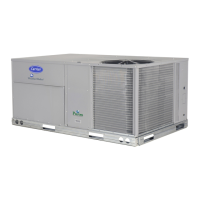40
Fig. 50 — Convenience Outlet Location (Sizes 07-14)
Installing Weatherproof Cover
A weatherproof while-in-use cover for the factory-installed
convenience outlets is now required by UL standards. This
cover cannot be factory-mounted due its depth; it must be in-
stalled at unit installation. For shipment, the convenience outlet
is covered with a blank cover plate.
The weatherproof cover kit is shipped in the unit’s control box.
The kit includes the hinged cover, a backing plate and gasket.
DISCONNECT ALL POWER TO UNIT AND CONVE-
NIENCE OUTLET. LOCK-OUT AND TAG-OUT ALL
POWER.
Remove the blank cover plate at the convenience outlet;
discard the blank cover.
Loosen the two screws at the GFCI duplex outlet, until approx-
imately
1
/
2
-in. (13 mm) under screw heads are exposed. Press
the gasket over the screw heads. Slip the backing plate over the
screw heads at the keyhole slots and align with the gasket;
tighten the two screws until snug (do not over-tighten).
Mount the weatherproof cover to the backing plate as shown in
Fig. 51. Remove two slot fillers in the bottom of the cover to
permit service tool cords to exit the cover. Check for full clos-
ing and latching.
Fig. 51 — Weatherproof Cover Installation
(Sizes 07-14)
Non-powered type
This type requires the field installation of a general-purpose
125-v 15-A circuit powered from a source elsewhere in the
building. Observe national and local codes when selecting wire
size, fuse or breaker requirements, and disconnect switch size
and location. Route 125-v power supply conductors into the
bottom of the utility box containing the duplex receptacle.
Unit-powered type
A unit-mounted transformer is factory-installed to stepdown
the main power supply voltage to the unit to 115-v at the du-
plex receptacle. This option also includes a manual switch with
fuse, located in a utility box and mounted on a bracket behind
the convenience outlet; access is through the unit’s control box
access panel. See Fig. 50.
The primary leads to the convenience outlet transformer are
not factory-connected. Selection of primary power source is a
customer option. If local codes permit, the transformer primary
leads can be connected at the line-side terminals on the unit-
mounted non-fused disconnect or HACR breaker switch; this
will provide service power to the unit when the unit disconnect
switch or HACR switch is open. Other connection methods
will result in the convenience outlet circuit being de-energized
when the unit disconnect or HACR switch is open. See Fig. 52.
Fig. 52 — Powered Convenience Outlet Wiring
(Sizes 07-14)
Test the GFCI receptacle by pressing the TEST button on the
face of the receptacle to trip and open the receptacle. Check for
proper grounding wires and power line phasing if the GFCI re-
ceptacle does not trip as required. Press the RESET button to
clear the tripped condition.
Fuse on power type
The factory fuse is a Bussman
1
“Fusetron” T-15, non-renew-
able screw-in (Edison base) type plug fuse.
CONTROL
BOX
ACCESS
PANEL
CONVENIENCE
OUTLET
GFCI
PWRD-CO
FUSE
SWITCH
PWRD-CO
TRANSFORMER
COVER - WHILE-IN-USE
WEATHERPROOF
BASEPLATE FOR
GFCI RECEPTACLE
GASKET
GFCI RECEPTACLE
NOT INCLUDED
T
O
P
TO
P
TOP
W
E
T
LOC
A
TI
O
N
S
W
E
T
L
O
C
A
TI
O
N
S
1. Bussman and Fusetron are trademarks of Cooper Technologies
Company.
UNIT
VOLTAGE
CONNECT
AS
PRIMARY
CONNECTIONS
TRANSFORMER
TERMINALS
208,230 240
L1: RED +YEL
L2: BLU + GRA
H1 + H3
H2 + H4
460 480
L1: RED
Splice BLU + YEL
L2: GRA
H1
H2 + H3
H4
575 600
L1: RED
L2: GRA
H1
H2

